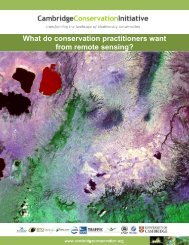CONSERVING BIODIVERSITY & DELIVERING ECOSYSTEM SERVICES
conserving biodiversity & delivering ecosystem services
conserving biodiversity & delivering ecosystem services
Create successful ePaper yourself
Turn your PDF publications into a flip-book with our unique Google optimized e-Paper software.
The National Parks and Wildlife Conservation Act 1973 and Buffer Zone<br />
Management Regulation 1996 are the legal tools for Protected Area declaration<br />
and management. There are several different types of ‘protected area’ in Nepal,<br />
including: National Parks, Wildlife Reserves, Conservation Areas and Hunting<br />
Reserves. To date, Protected Areas constitute more than 23% of the total land area<br />
of the country (more than 3.4 million ha). For those Protected Areas with buffer<br />
zones, 30–50% of the total income is shared with local communities (through<br />
Buffer Zone Management Committees) to implement community development<br />
activities. Altogether, 12 buffer zones have been declared so far, embracing over<br />
80 Village Development Committees in 27 districts and over 700,000 people.<br />
(Jenny Birch)<br />
Communities adjacent to protected areas benefit directly from the services flowing from the protected habitats. However, they often<br />
also bear the costs of restricted access to local resources. A challenge for Protected Area managers is therefore to balance the<br />
requirements to conserve biodiversity, with the wider benefits of the site and the immediate needs of the local community.<br />
Coverage of protected areas in Nepal is already well above that set by the CBD’s global ‘Aichi Biodiversity Target’ 11 for 2020 (17%).<br />
However, Target 11 also stipulates that ‘areas of particular importance for biodiversity and ecosystem services are conserved through<br />
effectively and equitably managed, ecologically representative and well-connected systems of protected areas’, and hence meeting this<br />
target is still a challenge for Nepal. There are also more than 1.23 million ha of Community Forest in Nepal (nearly 22% of the total forest<br />
area) which are managed for a range of objectives, products and services, including for biodiversity conservation (see Forests below).<br />
This study shows: Nepal’s protected Important Bird Areas (IBAs) are currently providing a wide range of benefits at the local,<br />
national and global level. For example, many of the protected IBAs (e.g. Chitwan National Park and Annapurna Conservation<br />
Area) are popular destinations for recreation and tourism, providing important sources of national and local income (through, e.g.<br />
creating local jobs, supporting national businesses and generating spending in the wider economy), and this service is expected<br />
to increase by 2020.<br />
Key recommendations<br />
■ At Protected Areas, examine the distribution of ecosystem service benefits in more detail, and establish ecosystem<br />
service-based development initiatives that maximise and redistribute benefits in ways that are sustainable, equitable,<br />
reduce pressures on biodiversity and incentivise conservation<br />
■ At all Protected Areas, develop community-NGO-Park Authority collaborations to ensure regular monitoring of<br />
biodiversity and ecosystem services, in order to report on trends and management effectiveness<br />
■ For Tamur and Mai Valleys, and Phulchoki Mountain Forests, explore the possibility of establishing Conservation Areas that<br />
retains the rights of the local community Forest User Groups, and allows income generation from well managed tourism<br />
■ For the Farmlands of Lumbini, including the Khadara Phanta grasslands, explore options for better protection<br />
<br />
Nepal has 5.83 million ha of forested land. This is divided into national and private<br />
forests with five sub-categories on the basis of management regimes, including<br />
Government managed forests, community forests, protected forests, leasehold<br />
forests and religious forests. Nepal has a well-defined policy and legal framework<br />
for the forestry sector, which is guided by the Master Plan for the Forestry Sector<br />
1989 and periodic national plans. The Ministry of Forests and Soil Conservation is<br />
responsible for a number of relevant policies including the Leasehold Forestry<br />
Policy Guidelines 2003, Herbs and non-timber forest product / NTFP Development<br />
Policy 2004, and Gender and Social Inclusion Strategy in the Forestry Sector 2004–<br />
(David Thomas)<br />
2019. The Forest Act 1993 supports the handover of the national forest to<br />
adjoining Forest User Groups (FUGs) which are empowered to manage parts of the forest estate themselves. Some 18,000 FUGs have<br />
been established to date, the majority belonging to the Federation of Community Forestry Users, Nepal (FECOFUN), which acts as a<br />
conduit for local communities to input into policy processes. Community forestry has been successful in: restoring degraded land<br />
and greenery; increasing and conserving biodiversity; increasing the supply of forest products; empowering rural women, the poor<br />
and disadvantaged groups; promoting income generation and community development activities; and in improving livelihoods of<br />
people in rural areas. Nepal is also engaged in REDD+ activities which aim to reduce emissions from deforestation and forest<br />
degradation, support the conservation and sustainable management of forests, and enhancement of forest carbon stocks.<br />
This study shows: Across the network of IBAs, the area of forest cover is expected to decrease by about one-third by 2020 if current<br />
pressures and trends continue. Some ecosystem services delivered by forests at IBAs would decline as a result, including benefits<br />
that are particularly important to local people, such as supply of harvested wild goods, quality of climate and air, and patterns of<br />
water flows. On the other hand, benefits would be realised from cultivated food as a result of increased agricultural land.<br />
<br />
Key recommendations<br />
■ Establish ‘green enterprises’ and other sustainable livelihood options to minimise the pressure on forests<br />
■ Work with community Forest User Groups to improve the sustainable management and local governance of forest<br />
resources for the benefit of both people and wildlife<br />
■ Work with local communities to restore natural forest, develop native species plantations for local needs and discourage<br />
illegal logging of timber<br />
■ Ensure that appropriate biodiversity and social safeguards are applied to national REDD+ activities




